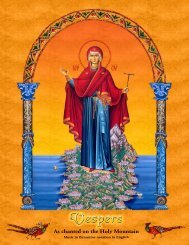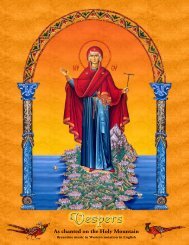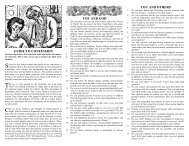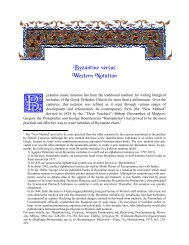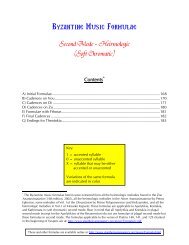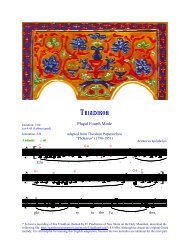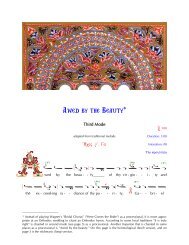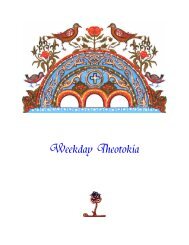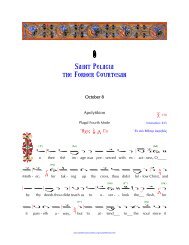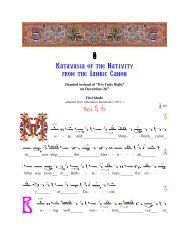Reading Psalmodia (PDF) - St. Anthony's Monastery
Reading Psalmodia (PDF) - St. Anthony's Monastery
Reading Psalmodia (PDF) - St. Anthony's Monastery
Create successful ePaper yourself
Turn your PDF publications into a flip-book with our unique Google optimized e-Paper software.
Pappadic DiDominant Notes: Irmic & Short <strong>St</strong>icheric Vou, DiSlow <strong>St</strong>ichericPa, Vu & DiMODES: The Fourth Tone makes use of a complex family of modes. Legetos, a diatonicmode based on Vu is used in short Irmic and short <strong>St</strong>icheric melodies. (In practise, Greekand Cypriot Psaltai generally sing Legetos to a distinctly non-diatonic tuning.) A secondDiatonic mode based on Pa and Di , but having its Final and Emphatic Cadences on Vuis used in slow sticheric melodies. A third mode based on Di is used in some Ornatemelodies and in the Pappadic style.In Legetos it is usual to sharpen slightly the Pa below the basic Vu both when Pa acts ineffect as a leading note to Vu and in the Locus Bou-Pa-Ni-Pa Vou.A second and very common mode used in short Irmic and <strong>St</strong>icheric styles uses both aslightly sharpened Pa and a slightly flattened Ke; this makes it virtuallyindistinguishable from the soft chromatic mode of Tone Two. It is now customary toaccept that this mode of Four is indeed in the soft chromatic scale and to mark it withthe signs and tokens of that scale. This soft chromatic mode is of great importance sinceit is used for Theos Kyrios and for most Apolytikia and Kontakia in Tone Four. TheEmphatic Cadence of this mode is normally on Di .When the note Zo' occurs as an unemphatic note in a descending passage or when themelody rises to it and then descends without emphasising it, it is frequently flattened.The automelon kathisma Kataplagi Iosif is sung to a very beautiful melody in a mode ofthe soft (or sometimes the hard) chromatic scale. Since Kataplagi Iosif is the automelon ofvery many prosomia, care must be taken to distinguish this, the proper melody of theautomelon, from a second melody in a mode of the soft chromatic scale used for theprosomia of Kataplagi Iosif when they are sung as apolytikia - this is an important set ofapolytikia including Apegrafeto Pote, Etimazou Bēthleem, Ek tis Rizis Iessai and I Amnas Sou.An uncommon but beautiful enharmonic mode of the Fourth Tone also exists.TONE FIVE or TONE PLAGAL ONEScale: DIATONIC.Basic Note: Short Irmic & <strong>St</strong>icheric modes: KeSlow Irmic & <strong>St</strong>icheric modes: Pa or KeDominant Notes: Short Irmic & <strong>St</strong>icheric: Ke, Pa, NiSlow Irmic & <strong>St</strong>icheric:Pa, Di , KeMODES: Most pieces in Plagal I use a mode of the diatonic scale based on Ke or theidentical mode transposed to the base Pa. Pieces in the Slow, Ornate or Pappadic stylesfrequently use a more complex mode which uses both the diatonic scale on the base Paand the enharmonic scale on Ga used in Tone Three. Some pieces in these slow stylesare written in what is called the Pentaphonic mode of Plagal I; this is a beautiful andlyrical mode which has Pa, Ga, Di and Zo b ' as its Dominant Notes, and many of itsphrases begin typically on Zo b '.



